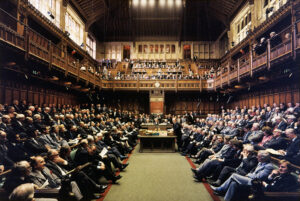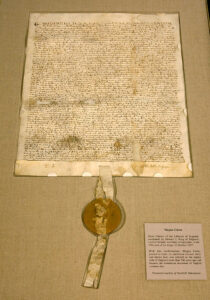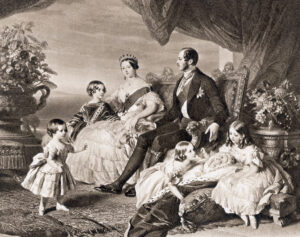The Purpose and Power of the British Monarchy Today
Does the royal family still have any power?
By: Mark Angelides | April 6, 2021 | 650 Words

‘King John signing Magna Charta at Runnydale’ From The Mighty Army, by W. M. Letts, illustrated by Stephen Reid. (Photo by The Print Collector/Getty Images)
When the thirteen colonies of British America declared their independence from King George III, it sparked the Revolutionary War. The American leaders wanted to be free from rule of monarchs and create their own fate. We know what happened to the colonies, but what became of the king and his line?
The following centuries were not kind to the idea of the divine right of kings. During the 16th and 17th centuries, a king was believed to be appointed by God. Therefore, any decision he made was considered automatically right. Any rebellion against him was considered a rebellion against God. But those days were already coming to an end when the Revolution occurred.

Britain’s House of Commons in session. (Getty Images)
Today, several European countries retain their royal families, but without the power they once had. Britain has kept its monarchy to this day – but it was actually one of the first European nations to question the absolute rule of a king or queen.
The English Parliament was formed in 1215, while the Parliament of Scotland was established in 1235. Since the signing of the Magna Carta in the year 1215, power was slowly taken from the monarch and given to the Parliament. Eventually, in 1707, the British Parliament was created from this tradition with the joining of the countries of the British Isles. The Parliament is embodied in the House of Commons and the House of Lords – the two chambers of government. They’re similar in some ways to the U.S. House of Representatives and Senate. While the House of Commons is made up of ministers elected by the people, the House of Lords is filled with “lords,” who are either born into the position or appointed.

Magna Carta (Photo by Alex Wong/Getty Images)
In 1688, the English Parliament decided that King James II was not acting in the best interests of the country and removed him, installing William III on the throne; from here on, the crown would answer to the government. This brought with it a Bill of Rights and the end of the monarch’s power to remove a parliament.
The king was left with just two real powers. The first being that he could appoint ministers, the second that he could veto any law passed by Parliament. However, the power of royal veto hasn’t been used since 1708.
It is often said that the American revolutionaries threw off the yoke of the British Crown, but by this time, power in Britain resided with the Parliament.
From Queen Victoria’s rise to the throne in 1837 until Queen Elizabeth II in 1952, British monarchs have been largely at their respective governments’ whim. It is perhaps the worst position of all for a king or queen: plenty of responsibility but no real power outside of ceremonial duties such as opening a new parliament and inviting a new Prime Minister to form a government.
Today’s monarch does, however, retain two useful roles:
- When no side is able to form a majority in the Parliament, he or she can give strong “advice” on appointing a caretaker government.
- If the Prime Minister loses a vote of no confidence and refuses to step aside, the king or queen could dismiss the person (although they would only do so with the consent of Parliament).

Queen Victoria and Albert with the Royal Family. (Getty Images)
After splitting in 1776, Britain and the U.S. continued to evolve on their own – but both have ended up following a path similar to many nations in the years since.
Today, the British have a similar relationship with their government as Americans. They vote, and sometimes they stand for office. Despite the split between the two nations all those years ago, the governments and the people have followed a similar trajectory.
















